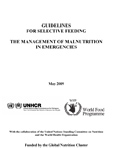
|
UNHCR, WFP
Published in : 2009
Available in : English
These guidelines are intended as a practical guide to design, implement, monitor and evaluate selective feeding programmes in emergency situations, namely to answer the following key questions:
- Which type and combination of selective feeding programmes are required?
- How should each be implemented?
The target audience includes:
- Nutrition experts
- Programme managers and decision-makers in the United Nations (UN) system
- Government officials within relevant ministries
- Donor agencies
- Non-Governmental Organizations (NGOs)
Documents :
Guidelines for Selective Feeding: The Management of Malnutrition in Emergencies (PDF, 1.40Mb)
Annotated Bibliography (PDF, 2.71Mb)
Originally posted at : www.ennonline.net/pool/files/ife/wfp-unhcr-sfp-guidelines.pdf
|
This resource is listed under:
Themes : Emergency, general, Micronutrients, general, Nutrition and health/disease, general, Nutrition assessments and M&E, general, Nutrition planning, policy and programme, general, Undernutrition, general, Food Aid, Food Aid, Hygiene, water and sanitation, Micronutrient deficiencies, Micronutrient deficiencies, Micronutrient Supplementation, Micronutrient Supplementation, Micronutrient Supplementation, Monitoring and evaluation, Monitoring and evaluation, Programmes, Supplementary feeding, Supplementary feeding, Therapeutic feeding, RUF/RUTF, Therapeutic feeding, RUF/RUTF, Wasting
Resource types : Guidelines, Operational guidance: Programme and implementation
Working groups : Nutrition in Emergencies
|